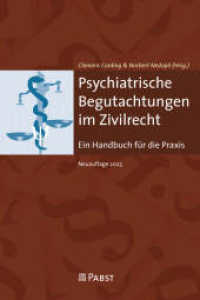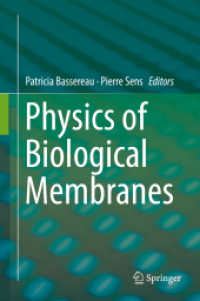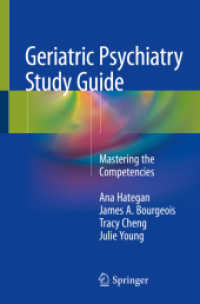- ホーム
- > 洋書
- > ドイツ書
- > Social Sciences, Jurisprudence & Economy
- > Politics, Society, Work
- > social science
Full Description
This book examines the use of agent-based modelling (ABM) in population studies, from concepts to applications, best practices to future developments. It features papers written by leading experts in the field that will help readers to better understand the usefulness of ABM for population projections, how ABM can be injected with empirical data to achieve a better match between model and reality, how geographic information can be fruitfully used in ABM, and how ABM results can be reported effectively and correctly.
Coverage ranges from detailing the relation between ABM and existing paradigms in population studies to infusing agent-based models with empirical data. The papers show the benefits that ABM offers the field, including enhanced theory formation by better linking the micro level with the macro level, the ability to represent populations more adequately as complex systems, and the possibility to study rare events and the implications of alternative mechanisms in artificial laboratories.
In addition, readers will discover guidelines and best practices with detailed examples of how to apply agent-based models in different areas of population research, including human mating behaviour, migration, and socio-structural determinants of health behaviours.
Earlier versions of the papers in this book have been presented at the workshop "Recent Developments and Future Directions in Agent-Based Modelling in Population Studies," which took place at the University of Leuven (KU Leuven), Belgium, in September 2014. The book will contribute to the development of best practices in the field and will provide a solid point of reference for scholars who want to start using agent-based modelling in their own research.
Contents
Perspectives on Agent-Based Modelling in Population Studies:1: Introduction: Agent-Based Modelling as a Tool to Advance Evolutionary Population Theory: Jan Van Bavel and André Grow.-2: Model-Based Demography: Towards a Research Agenda: Daniel Courgeau, Jakub Bijak, Robert Franck, and Eric Silverman.-3: The Role of Social Interactions in Demography: An Agent-Based Modelling Approach: Alexia Prskawetz.- II. Designing, Analysing, and Reporting Agent-Based Models:4: Agent-based Computational Demography and Microsimulation using JAS-mine: Matteo Richiardi and Ross E. Richardson.- 5: Simulating Synthetic Life Courses of Individuals and Couples, and Mate Matching: Sabine Zinn.- 6: Using Survey Data for Agent-Based Modeling: Design and Challenges in a Model of Armed Conflict and Population Change: Nathalie E. Williams, Michelle L. O'Brien, and Xiaozheng Yao.- 7: Regression Metamodels for Sensitivity Analysis in Agent-Based Computational Demography: André Grow.- 8: Design and Analysis of Demographic Simulations: Jason Hilton and Jakub Bijak.- 9: How to Describe Agent-Based Models in Population Studies?: Jürgen Groeneveld, Anna Klabunde, Michelle L. O'Brien, and André Grow.- III. Modelling Decision Processes: 10: The decision to emigrate: A simulation model based on the theory of planned behaviour: Frans Willekens.- 11: Deciding to Disclose: A Decision Theoretic Agent Model of Pregnancy and Alcohol Misuse: Jonathan Gray, Jakub Bijak, and Seth Bullock: IV. Family Formation and Fertility: 12: An Agent-Based Model of Sex Ratio at Birth Distortions: Ridhi Kashyap and Francisco Villavicencio.- 13: Exploring the Role of Communication in Shaping Fertility Transition Patterns in Space and Time: Sebastian Klüsener, Francesco Scalone, and Martin Dribe.- 14: Feedback Mechanisms in the Postponement of Fertility in Spain: Daniel Ciganda and Francisco Villavicencio.- V. Health, Mortality, and Support in Old Age: 15: Linking income, transfers, and social support in an agent-based family exchange model: Fanny A. Kluge and Tobias C. Vogt.- 16: Agent-Based Modelling to Inform Health Intervention Strategies: The case of severe acute malnutrition in children in high-burden low-income countries: Hedwig Deconinck, Carine Van Malderen, Niko Speybroeck, Jean Macq, and Jean-Christophe Chiem.- 17: Exploring Contingent Inequalities - Building the Theoretical Health Inequality Model: Michael Wolfson, Steve Gribble, and Reed Beall.








